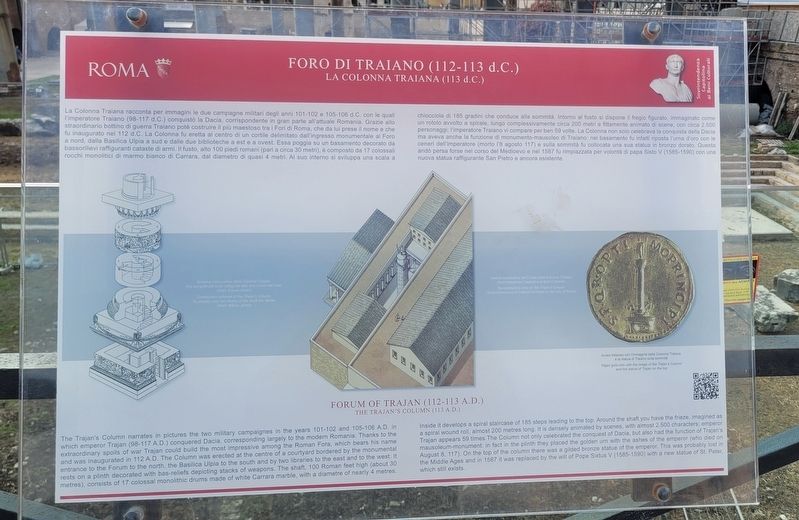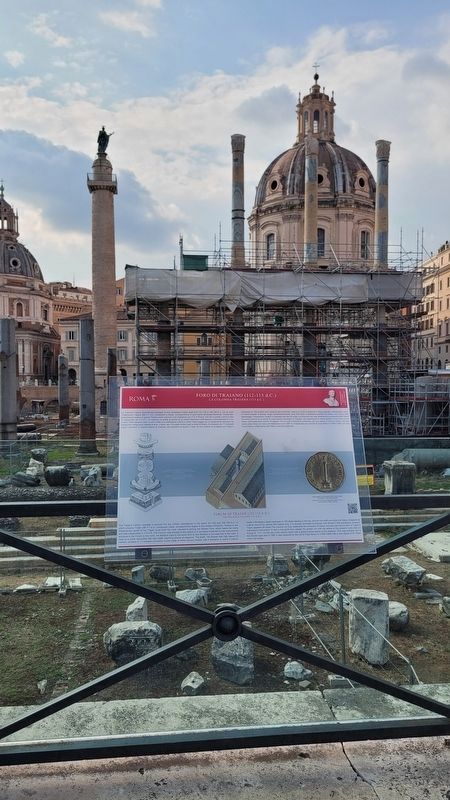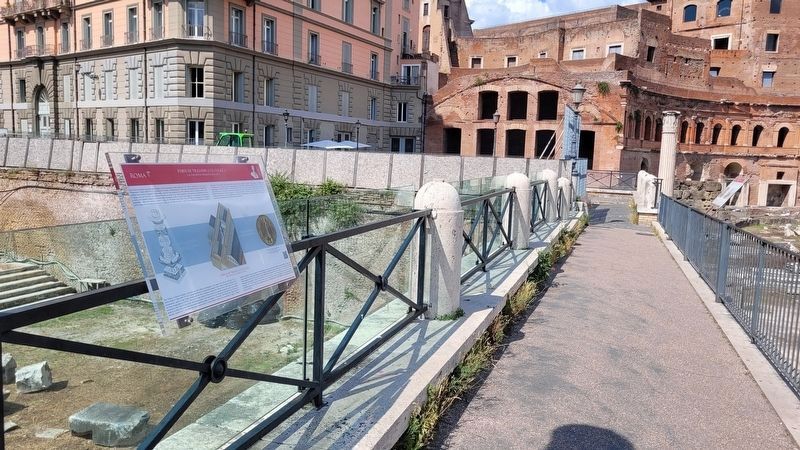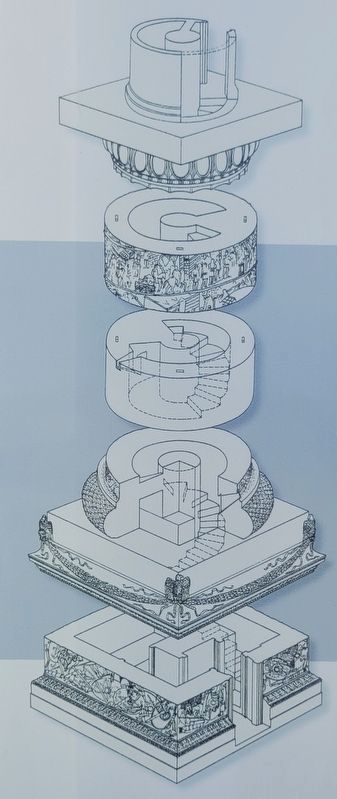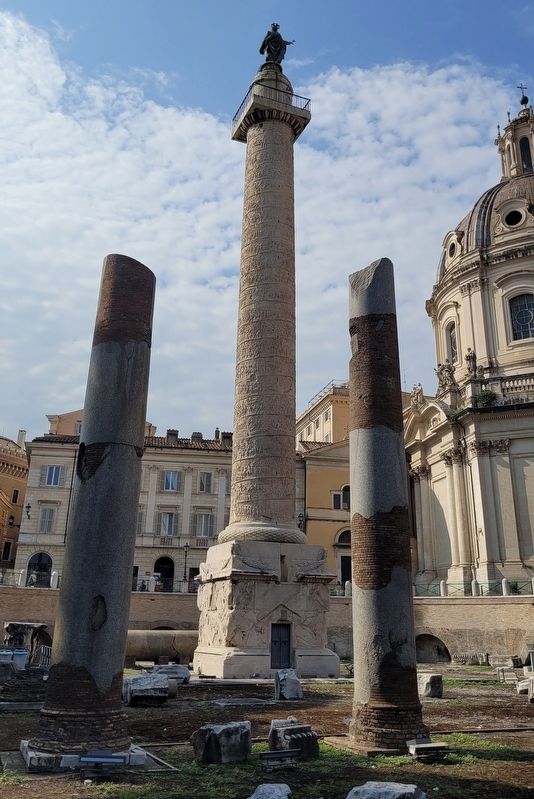Monti in Roma in Città metropolitana di Roma Capitale, Latium, Rome, Italy — Central Italy (Tyrrhenian Coast)
Foro di Traiano (112-113 d.C.) / Forum of Trajan (112-113 A.D.)
La Colonna Traiana (113 d.C.) / The Trajan's Column (113 A.D.)
Inscription.
Didascalie
Sinistra: Schema compositivo della Colonna Traiana Per semplificare sono raffigurati solo due rocchi del fusto (Mark Wilson Jones)
Centro: Veduta ricostruttiva del Cortile della Colonna Traiana (Sovrintendenza Capitolina ai Beni Cultural)
Destro: Aureo traianeo con l'immagine della Colonna Traiana e la statua di Traiano sulla sommità
The Trajan's Column narrates in pictures the two military campaignes in the years 101-102 and 105-106 A.D. in which emperor Trajan (98-117 A.D.) conquered Dacia, corresponding largely to the modern Romania. Thanks to the extraordinary spoils of war Trajan could build the most impressive among the Roman Fora, which bears his name and was inaugurated in 112 A.D. The Column was erected at the centre of a courtyard bordered by the monumental entrance to the Forum to the north, the Basilica Ulpia to the south and
by two libraries to the east and to the west. It rests on a plinth decorated with bas-reliefs depicting stacks of weapons. The shaft, 100 Roman feet high (about 30 metres), consists of 17 colossal monolithic drums made of white Carrara marble, with a diametre of nearly 4 metres. Inside it develops a spiral staircase of 185 steps leading to the top. Around the shaft you have the frieze, imagined as a spiral wound roll, almost 200 metres long. It is densely animated by scenes, with almost 2.500 characters; emperor Trajan appears 59 times. The Column not only celebrated the conquest of Dacia, but also had the function of Trajan's mausoleum-monument: in fact in the plinth they placed the golden urn with the ashes of the emperor (who died on August 8, 117). On the top of the column there was a gilded bronze statue of the emperor. This was probably lost in the Middle Ages and in 1587 it was replaced by the will of Pope Sixtus V (1585-1590) with a new statue of St. Peter, which still exists.
Captions
Left: Composition scheme of the Trajan's Column. To simplify only two drums of the shaft are shown (Mark Wilson Jones)
Center: Reconstructive view of the Trajan's Column (Superintendency of Cultural Heritage for the City of Rome)
Right: Trajan gold coin with the image of the Trajan's Column and the statue of Trajan on the
top
Erected by Roma and Sovrintendenza Capitolina ai Beni Culturali.
Topics. This historical marker is listed in these topic lists: Anthropology & Archaeology • Architecture • Wars, Non-US. A significant historical year for this entry is 101 CE.
Location. 41° 53.712′ N, 12° 29.098′ E. Marker is in Roma, Lazio (Latium, Rome), in Città metropolitana di Roma Capitale. It is in Monti. Marker is on Foro Traiano, 0.1 kilometers east of Via dei Fori Imperiali. The marker is located along the pathway in the Piazza Foro Traino. Touch for map. Marker is in this post office area: Roma, Lazio 00187, Italy. Touch for directions.
Other nearby markers. At least 8 other markers are within walking distance of this marker. Strutture Medievali e Moderne (XII-XX Secolo) / Medieval and Modern Structures (12th-20th Century) (within shouting distance of this marker); Foro di Traiano / Forum of Trajan (within shouting distance of this marker); Palazzo Valentini (about 120 meters away, measured in a direct line); Auditoria di Adriano / Hadrian's Auditoria (about 150 meters away); Hotel Traiano (about 150 meters away); Vittoriano (about 150 meters away); Chiesa di Santa Maria di Loreto / Church of Santa Maria of Loreto (about 150 meters away); Italian government officially recognized Czech-Slovakia (about 180 meters away). Touch for a list and map of all markers in Roma.
More about this marker. The marker is located near the Parco Archeologico del Colosseo (Roman Forum Archaeological Park) and the pathway where the marker is located does not require an entry fee to walk. The area directly below the pathway does require an entry fee to visit.
Also see . . .
1. Forum of Trajan. Roma and Sovrintendenza Capitolina ai Beni Culturali
At the end of the Ist century A.D., the valley of the Imperial Fora was completely occupied by four forums that up to that point had been built there. In chronological order they were: the Forum of Caesar (46 B.C.), the Forum of Augustus (2 B.C.), the Forum of Peace (75 A.D.) and the Forum of Nerva (97 A.D.), the later at the behest and in large part built by the emperor Domitian (81-97 A.D.).(Submitted on November 23, 2023, by James Hulse of Medina, Texas.)
2. Trajan's Column. Wikipedia
Trajan's Column (Italian: Colonna Traiana, Latin: Columna Traiani) is a Roman triumphal column in Rome, Italy, that commemorates Roman emperor Trajan's victory in the Dacian Wars. It was probably constructed under the supervision of the architect Apollodorus of Damascus at the order of the Roman Senate. It is located in Trajan's Forum, north of the Roman Forum. Completed in AD 113, the freestanding column is most famous for its spiral bas relief, which depicts the wars between the Romans and Dacians (101–102 and 105–106). Its design has inspired numerous victory columns, both ancient and modern.(Submitted on November 23, 2023, by James Hulse of Medina, Texas.)
Credits. This page was last revised on November 24, 2023. It was originally submitted on November 22, 2023, by James Hulse of Medina, Texas. This page has been viewed 47 times since then and 9 times this year. Photos: 1, 2, 3, 4, 5. submitted on November 23, 2023, by James Hulse of Medina, Texas.
